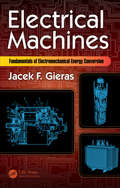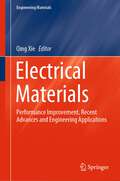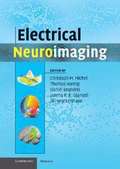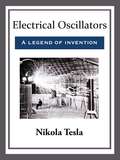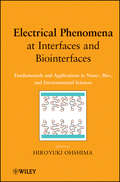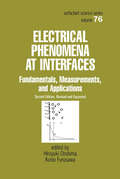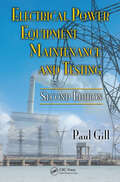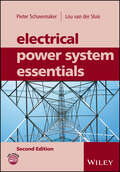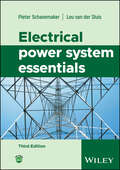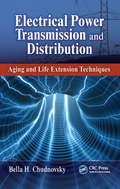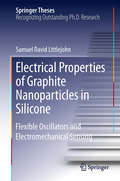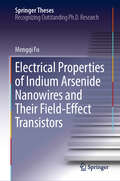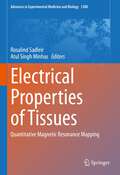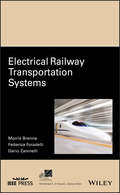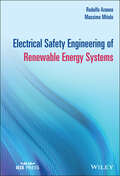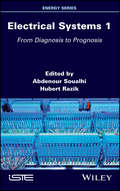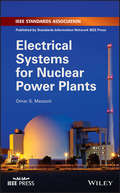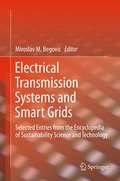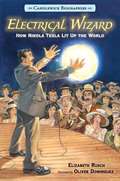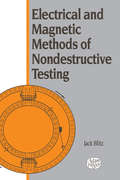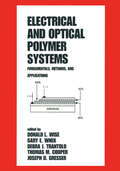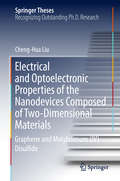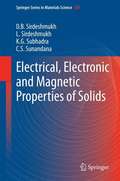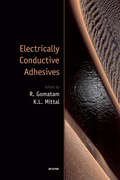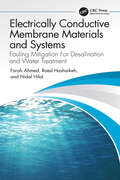- Table View
- List View
Electrical Machines: Fundamentals of Electromechanical Energy Conversion
by Jacek F. GierasThis book endeavors to break the stereotype that basic electrical machine courses are limited only to transformers, DC brush machines, induction machines, and wound-field synchronous machines. It is intended to serve as a textbook for basic courses on Electrical Machines covering the fundamentals of the electromechanical energy conversion, transformers, classical electrical machines, i.e., DC brush machines, induction machines, wound-field rotor synchronous machines and modern electrical machines, i.e., switched reluctance machines (SRM) and permanent magnet (PM) brushless machines. In addition to academic research and teaching, the author has worked for over 18 years in US high-technology corporative businesses providing solutions to problems such as design, simulation, manufacturing and laboratory testing of large variety of electrical machines for electric traction, energy generation, marine propulsion, and aerospace electric systems.
Electrical Materials: Performance Improvement, Recent Advances and Engineering Applications (Engineering Materials)
by Peng Wang Jun Xie Yiyi ZhangThis book highlights the latest advances in advanced insulating materials. Energy crisis and environmental pollution are two major themes currently faced by the human society. It is of unprecedented strategic importance to construct a strong smart grid with super/ultra-high voltage network as the backbone and clean energy transmission as the leading force. However, the performance of electrical equipment and devices is greatly determined by the properties of their insulating materials, especially when they have to work in extreme circumstances including high-temperature differences, intense radiation, and strong electric fields. The key advantage of polymers is that their properties could be adjusted by changing their chemical composition and molecular structure. Research on polymer insulating materials has been highly successful as progress has been made in characterizing these properties, designing molecular structures, and studying polymers’ specialized properties. On the other hand, nanodielectrics are prepared by adding certain nanoscale fillers into a polymer matrix to yield better electrical, thermal, and mechanical properties. When the particle pretreatment methods and the content or category of fillers are adjusted, nanodielectrics tend to have greater breakdown strength as well as better high-temperature resistance and space charge suppression. Therefore, this book covers investigations of properties of insulating materials that explore their interface effects and composite structures and introduces findings in methods that improve the performance of electrical devices. The book is not only used as a timely reference for engineering and technical personnel in related fields but also as a comprehensive textbook for college students.
Electrical Neuroimaging
by Christoph M. Michel Thomas Koenig Daniel Brandeis Jiří Wackermann Lorena R. R. GianottiElectrical neuroimaging is based on the analysis of brain electrical activity recorded from the human scalp with multichannel EEG. It offers enormous potential for the dynamic mapping of brain functions, and for the non-invasive diagnosis of neurological and psychiatric conditions. This authoritative reference gives a systematic overview of new electrical imaging methods, with a sound introduction to the basics of multichannel recording of EEG and event-related potential (ERP) data, as well as spatio-temporal analysis of the potential fields. The book enables researchers to measure valid data, select and apply appropriate analysis strategies, and avoid the most common mistakes when analyzing and interpreting EEG/ERP data. Importantly, it informs the research communities of the possibilities opened by these space-domain oriented approaches to the analysis of brain electrical activity, and of their potential to offer even more powerful diagnostic techniques when integrated with other clinically relevant data.
Electrical Oscillators
by Nikola TeslaNikola Tesla was a genius who revolutionized how the world looks at electricity. In 1893 he patented an electro-mechanical oscillator as a steam-powered electric generator. By his own account, one version of the oscillator caused an earthquake in New York City in 1898, for which it was accorded the moniker, "Tesla's earthquake machine."
Electrical Phenomena at Interfaces and Biointerfaces
by Hiroyuki OhshimaThis book bridges three different fields: nanoscience, bioscience, and environmental sciences. It starts with fundamental electrostatics at interfaces and includes a detailed description of fundamental theories dealing with electrical double layers around a charged particle, electrokinetics, and electrical double layer interaction between charged particles. The stated fundamentals are provided as the underpinnings of sections two, three, and four, which address electrokinetic phenomena that occur in nanoscience, bioscience, and environmental science. Applications in nanomaterials, fuel cells, electronic materials, biomaterials, stems cells, microbiology, water purificiaion, and humic substances are discussed.
Electrical Phenomena at Interfaces: Fundamentals: Measurements, and Applications (Surfactant Science Ser. #76)
by Hiroyuki Ohshima Kunio FurusawaRevising, updating and expanding information on developments since the late 1980s, the second edition of this work presents practical, fundamental material on interfacial electric phenomena in acqueous and nonaqueous systems, as well as their relation to colloid stability. The book includes 15 additional chapters that reflect collaborative efforts with new experts in the field.
Electrical Power Equipment Maintenance and Testing (Second Edition)
by Paul GillThe second edition of a bestseller, this definitive text covers all aspects of testing and maintenance of the equipment found in electrical power systems serving industrial, commercial, utility substations, and generating plants. It addresses practical aspects of routing testing and maintenance and presents both the methodologies and engineering basics needed to carry out these tasks. It is an essential reference for engineers and technicians responsible for the operation, maintenance, and testing of power system equipment. Comprehensive coverage includes dielectric theory, dissolved gas analysis, cable fault locating, ground resistance measurements, and power factor, dissipation factor, DC, breaker, and relay testing methods.
Electrical Power System Essentials
by Lou van der Sluis Pieter SchavemakerThe electrical power supply is about to change; future generation will increasingly take place in and near local neighborhoods with diminishing reliance on distant power plants. The existing grid is not adapted for this purpose as it is largely a remnant from the 20th century. Can the grid be transformed into an intelligent and flexible grid that is future proof? This revised edition of Electrical Power System Essentials contains not only an accessible, broad and up-to-date overview of alternating current (AC) power systems, but also end-of-chapter exercises in every chapter, aiding readers in their understanding of the material introduced. With an original approach the book covers the generation of electric energy from thermal power plants as from renewable energy sources and treats the incorporation of power electronic devices and FACTS. Throughout there are examples and case studies that back up the theory or techniques presented. The authors set out information on mathematical modelling and equations in appendices rather than integrated in the main text. This unique approach distinguishes it from other text books on Electrical Power Systems and makes the resource highly accessible for undergraduate students and readers without a technical background directly related to power engineering. After laying out the basics for a steady-state analysis of the three-phase power system, the book examines: generation, transmission, distribution, and utilization of electric energy wind energy, solar energy and hydro power power system protection and circuit breakers power system control and operation the organization of electricity markets and the changes currently taking place system blackouts future developments in power systems, HVDC connections and smart grids The book is supplemented by a companion website from which teaching materials can be downloaded.
Electrical Power System Essentials
by Pieter Schavemaker Lou van der SluisA highly accessible resource covering the basics of the design and operation of electrical power systems with minimal technical background required Electrical Power System Essentials delivers a thorough introduction to the electrical power system and its functioning, and the changes that come with the worldwide energy transition process. This revised and updated Third Edition includes new material on HVDC developments, electricity markets, capacity calculation (NTC and flow-based), power system protection, and energy storage. Discussions on how renewable sources play a more dominant role in the generation of electrical energy and the effects they have on the control and operation of the grid and electricity markets are also included. Written in the accessible style that has made previous editions so popular with readers, this book restricts math content to the Appendix in order to maintain an easy reading experience of the main text while still providing complete coverage. A companion website includes downloadable teaching materials, and accessory videos are viewable on the Wiley website (www.wiley.com/go/powersystem3e) and YouTube (https://www.youtube.com/playlist?list=PLvaU1SY38TUV8JTwkf1taN-w_bQbCD0Ad). Topics discussed in the book include: Generation of electric energy, covering nuclear fission, wind energy and wind turbine concepts, hydropower and pumped storage, and solar powerElectricity markets, covering gas scarcity, its influence on the marginal price of electricity, and negative energy pricesFuture power systems, covering higher harmonics, increased use of cables instead of overhead transmission lines, distributed generation and power-electronic interfacesTransmission of electric energy, covering DC circuit breakers, wide area measurement systems, and distribution networks Electrical Power System Essentials is a perfect textbook for second- and third-year undergraduate electrical engineering students who need an accessible course text introducing concepts in power system engineering. The text is also valuable for other students and professionals who require an up-to-date reference on power systems technology.
Electrical Power Transmission and Distribution: Aging and Life Extension Techniques
by Bella H. ChudnovskyElectrical distribution and transmission systems are complex combinations of various conductive and insulating materials. When exposed to atmospheric corrosive gases, contaminants, extreme temperatures, vibrations, and other internal and external impacts, these systems deteriorate, and sooner or later their ability to function properly is destroyed. Electrical Power Transmission and Distribution: Aging and Life Extension Techniques offers practical guidance on ways to slow down the aging of these electrical systems, improve their performance, and extend their life. Recognize the Signs of Aging in Equipment—and Learn How to Slow It A reference manual for engineering, maintenance, and training personnel, this book analyzes the factors that cause materials to deteriorate and explains what you can do to reduce the impact of these factors. In one volume, it brings together extensive information previously scattered among manufacturers’ documentation, journal papers, conference proceedings, and general books on plating, lubrication, insulation, and other areas. Shows you how to identify the signs of equipment aging Helps you understand the causes of equipment deterioration Suggests practical techniques for protecting electrical apparatus from deterioration and damage Supplies information that can be used to develop manuals on proper maintenance procedures and choice of materials Provides numerous examples from industry This book combines research and engineering material with maintenance recommendations given in layperson’s terms, making it useful for readers from a range of backgrounds. In particular, it is a valuable resource for personnel responsible for the utilization, operation, and maintenance of electrical transmission and distribution equipment at power plants and industrial facilities.
Electrical Properties of Graphite Nanoparticles in Silicone: Flexible Oscillators and Electromechanical Sensing
by Samuel David LittlejohnThis thesis examines a novel class of flexible electronic material with great potential for use in the construction of stretchable amplifiers and memory elements. Most remarkably the composite material produces spontaneous oscillations that increase in frequency when pressure is applied to it. In this way, the material mimics the excitatory response of pressure-sensing neurons in the human skin. The composites, formed of silicone and graphitic nanoparticles, were prepared in several allotropic forms and functionalized with naphthalene diimide molecules. A systematic study is presented of the negative differential resistance (NDR) region of the current-voltage curves, which is responsible for the material's active properties. This study was conducted as a function of temperature, graphite filling fraction, scaling to reveal the break-up of the samples into electric field domains at the onset of the NDR region, and an electric-field induced metal-insulator transition in graphite nanoparticles. The effect of molecular functionalization on the miscibility threshold and the current-voltage curves is demonstrated. Room-temperature and low-temperature measurements were performed on these composite films under strains using a remote-controlled, custom-made step motor bench.
Electrical Properties of Indium Arsenide Nanowires and Their Field-Effect Transistors (Springer Theses)
by Mengqi FuThis book explores the impacts of important material parameters on the electrical properties of indium arsenide (InAs) nanowires, which offer a promising channel material for low-power electronic devices due to their small bandgap and high electron mobility. Smaller diameter nanowires are needed in order to scale down electronic devices and improve their performance. However, to date the properties of thin InAs nanowires and their sensitivity to various factors were not known. The book presents the first study of ultrathin InAs nanowires with diameters below 10 nm are studied, for the first time, establishing the channel in field-effect transistors (FETs) and the correlation between nanowire diameter and device performance. Moreover, it develops a novel method for directly correlating the atomic-level structure with the properties of individual nanowires and their device performance. Using this method, the electronic properties of InAs nanowires and the performance of the FETs they are used in are found to change with the crystal phases (wurtzite, zinc-blend or a mix phase), the axis direction and the growth method. These findings deepen our understanding of InAs nanowires and provide a potential way to tailor device performance by controlling the relevant parameters of the nanowires and devices.
Electrical Properties of Tissues: Quantitative Magnetic Resonance Mapping (Advances in Experimental Medicine and Biology #1380)
by Rosalind Sadleir Atul Singh MinhasThis book covers the latest developments in tissue electrical conductivity and current density imaging, increasingly popular as well as challenging applications of MRI. These applications are enabled by the acquisition of high-quality MR phase images. This book provides a practical description of the MRI physics needed to understand and acquire phase images in MRI and the key details required to reconstruct them into conductivity, current density or electric field distributions. Comprehensive details are provided about the electrical properties of biological tissues, computational modeling considerations, experimental methods, construction of non-biological and biological phantoms and MRI pulse sequences. An inclusive review of image reconstruction algorithms, and their potential applications is provided for applications directed at determining current density or electric fields, such as in transcranial DC or AC stimulation techniques; as well as electrical conductivity reconstructions that may be of use in quantitative MRI applications used to detect cancer or other pathologies. This is an excellent book for undergraduate and graduate students beginning to explore phase, current density, and conductivity imaging in MRI, and will also be of great use to researchers interested in the area of MR-based electrical property imaging.
Electrical Railway Transportation Systems (IEEE Press Series on Power Engineering)
by Morris Brenna Federica Foiadelli Dario ZaninelliAllows the reader to deepen their understanding of various technologies for both fixed power supply installations of railway systems and for railway rolling stock This book explores the electric railway systems that play a crucial role in the mitigation of congestion and pollution caused by road traffic. It is divided into two parts: the first covering fixed power supply systems, and the second concerning the systems for railway rolling stock. In particular, after a historical introduction to the framework of technological solutions in current use, the authors investigate electrification systems for the power supply of rail vehicles, trams, and subways. Electrical Railway Transportation Systems explores the direct current systems used throughout the world for urban and suburban transport, which are also used in various countries for regional transport. It provides a study of alternating current systems, whether for power supply frequency or for special railway frequency, that are used around the world for the electrification of railway lines, long-distance lines, and high-speed lines. In addition, this resource: Analyzes multiple railway systems from a theoretical and realizable vantage point, with particular regard to functionality, electromagnetic compatibility, and interferences with other electrical systems Studies electric traction railway vehicles, presenting various types of drives and auxiliary devices currently in circulation Discusses solutions employed to ensure interoperability of vehicles that run along lines powered by different systems (e.g., DC and AC, at different frequencies) Electrical Railway Transportation Systems is an ideal text for graduate students studying the subject as well as for industry professionals working in the field.
Electrical Safety Engineering of Renewable Energy Systems (IEEE Press)
by Rodolfo Araneo Massimo MitoloElectrical Safety Engineering of Renewable Energy Systems A reference to designing and developing electrical systems connected to renewable energies Electrical Safety Engineering of Renewable Energy Systems is an authoritative text that offers an in-depth exploration to the safety challenges of renewable systems. The authors—noted experts on the topic—cover a wide-range of renewable systems including photovoltaic, wind, and cogeneration and propose a safety-by-design approach. The book clearly illustrates safe behavior in complex real-world renewable energy systems using practical approaches. The book contains a review of the foundational electrical engineering topics and highlights how safety engineering links to the renewable energies. Designed as an accessible resource, the text discusses the most relevant and current topics supported by rigorous analytical, theoretical and numerical analyses. The authors also provide guidelines for readers interested in practical applications. This important book: Reviews of the major electrical engineering topics Shows how safety engineering links to the renewable energies Discusses the most relevant current topics in the field Provides solid theoretical and numerical explanations Written for students and professional electrical engineers, Electrical Safety Engineering of Renewable Energy Systems explores the safety challenges of renewable systems and proposes a safety-by-design approach, which is currently missing in current literature.
Electrical Systems 1: From Diagnosis to Prognosis
by Hubert Razik Abdenour SoualhiMethods of diagnosis and prognosis play a key role in the reliability and safety of industrial systems. Failure diagnosis requires the use of suitable sensors, which provide signals that are processed to monitor features (health indicators) for defects. These features are required to distinguish between operating states, in order to inform the operator of the severity level, or even the type, of a failure. Prognosis is defined as the estimation of a system's lifespan, including how long remains and how long has passed. It also encompasses the prediction of impending failures. This is a challenge that many researchers are currently trying to address. Electrical Systems, a book in two volumes, informs readers of the theoretical solutions to this problem, and the results obtained in several laboratories in France, Spain and further afield. To this end, many researchers from the scientific community have contributed to this book to share their research results.
Electrical Systems for Nuclear Power Plants
by Dr Omar S. MazzoniCovers all aspects of electrical systems for nuclear power plants written by an authority in the field Based on author Omar Mazzoni’s notes for a graduate level course he taught in Electrical Engineering, this book discusses all aspects of electrical systems for nuclear power plants, making reference to IEEE nuclear standards and regulatory documents. It covers such important topics as the requirements for equipment qualification, acceptance testing, periodic surveillance, and operational issues. It also provides excellent guidance for students in understanding the basis of nuclear plant electrical systems, the industry standards that are applicable, and the Nuclear Regulatory Commission’ rules for designing and operating nuclear plants. Electrical Systems for Nuclear Power Plants offers in-depth chapters covering: elements of a power system; special regulations and requirements; unique requirements of a Class 1E power system; nuclear plants containment electrical penetration assemblies; on-site emergency AC sources; on-site emergency DC sources; protective relaying; interface of the nuclear plant with the grid; station blackout (SBO) issues and regulations; review of electric power calculations; equipment aging and decommissioning; and electrical and control systems inspections. This valuable resource: Evaluates industry standards and their relationship to federal regulations Discusses Class 1E equipment, emergency generation, the single failure criterion, plant life, and plant inspection Includes exercise problems for each chapter Electrical Systems for Nuclear Power Plants is an ideal text for instructors and students in electrical power courses, as well as for engineers active in operating nuclear power plants.
Electrical Transmission Systems and Smart Grids
by Miroslav M. BegovicElectric transmission networks are among the largest human-made engineering systems: For example, the transmission network in the United States covers over 300,000 km of lines and is served by 500 companies (electric utilities). In sharp contrast to the very incremental developments of the last century, transmission and control technologies experienced a major breakthrough at the beginning of the 21st century. The rapid growth of new energy generation technologies (renewables), significant advances in information processing applied to system monitoring, planning, operation, control, and protection, radical changes in distribution networks, and key shifts in end user behavior (advanced metering and control of demand response) have combined to produce the modern integrated electrical infrastructure commonly referred to as the smart grid. Featuring state-of-the-art, peer-reviewed entries from the Encyclopedia of Sustainability Science and Technology, this book provides a detailed introduction to select key topics which span energy technology, engineering, and urban planning. Worldwide experts discuss the integration of electric energy infrastructure into the broader critical infrastructures of the modern world and their various interdependencies. Dedicated chapters cover specific topics ranging from underground transmission and distribution, to energy and water interdependence, and their implications for urban areas. Coverage also includes the key role of new policy initiatives as catalysts of change.
Electrical Wizard: How Nikola Tesla Lit Up The World (Candlewick Biographies Series)
by Elizabeth Rusch Oliver DominguezWhen a Serbian boy named Nikola Tesla was three, he stroked his cat and was enchanted by the electrical sparks. By the time he was a teenager, he had made a vow: Someday I will turn the power of Niagara Falls into electricity. Here is the story of the ambitious young man who brought life-changing ideas to America, despite the obstructive efforts of his hero-turned-rival, Thomas Edison. From using alternating current to light up the Chicago World's Fair to harnessing Niagara to electrify New York City and beyond, Nikola Tesla was a revolutionary ahead of his time. Remote controls, fluorescent lights, X-rays, speedometers, cell phones, even the radio -- all resulted from Nikola Tesla's inventions. Established biographer Elizabeth Rusch sheds light on this extraordinary figure, while fine artist Oliver Dominguez brings his life and inventions to vivid color. Back matter includes additional information about Tesla, scientific notes and explanations, source notes, a bibliography, and suggestions for further reading.
Electrical and Magnetic Methods of Nondestructive Testing
by Jack BlitzElectrical and Magnetic Methods of Nondestructive Testing presents a comprehensive account of the electrical and magnetic methods of nondestructive testing (NDT). The book begins with a discussion of the requirements for NDT and the criteria for the choice of a given method, followed by a summary of the general theory relating to electrical and magnetic testing techniques. Subsequent chapters discuss specific methods, including eddy current and flux-leakage techniques and microwave and potential drop methods. The appendix provides some useful programs for eddy current impedance analyses. These programs are in BASIC and can be run on PCs.
Electrical and Optical Polymer Systems: Fundamentals: Methods, and Applications (Plastics Engineering)
by Donald L. Wise"Offers background information, methods of characterization, and applications for electrical and optical polymers, including biopolymers, and tutorial sections that explain how to use the techniques."
Electrical and Optoelectronic Properties of the Nanodevices Composed of Two-Dimensional Materials: Graphene and Molybdenum (IV) Disulfide (Springer Theses)
by Cheng-Hua LiuThis thesis focuses on the transport and magneto-transport properties of graphene p-n-p junctions, such as the pronounced quantum Hall effect, a well-defined plateau–plateau transition point, and scaling behavior. In addition, it demonstrates persistent photoconductivity (PPC) in the monolayer MoS2 devices, an effect that can be attributed to random localized potential fluctuations in the devices. Further, it studies scaling behavior at zeroth Landau level and high performance of fractional values of quantum Hall plateaus in these graphene p-n-p devices. Moreover, it demonstrates a unique and efficient means of controlling the PPC effect in monolayer MoS2. This PPC effect may offer novel functionalities for MoS2-based optoelectronic applications in the future.
Electrical, Electronic and Magnetic Properties of Solids
by D. B. Sirdeshmukh L. Sirdeshmukh K. G. Subhadra C. S. SunandanaThis book about electrical, electronic and magnetic properties of solids gives guidance to understand the electrical conduction processes and magnetism in a whole range of solids: ionic solids, metals, semiconductors, fast-ion conductors and superconductors. The experimental discussion is enriched by related theories like the free electron theory and the band theory of solids. A large spectrum of topics is presented in this book: Hall effect, magnetoresistance, physics of semiconductors, functioning of semiconductor devices, fast-ion conduction, classical and modern aspects of superconductivity. The book explains the magnetic properties of solids and theoretical and experimental aspects of the various manifestations of magnetism, dia-, para-, ferro-, antiferro- and ferri-magnetism. The consideration of magnetic symmetry, magnetic structures and their experimental determination completes the spectrum of the book. Theories, techniques and applications of NMR and ESR complete the analytical spectrum presented. Some of these topics are not represented in standard books. Each topic is thoroughly treated. There are historical remarks and a discussion of the role of symmetry in the book. The book lays great emphasis on principles and concepts and is written in a comprehensive way. It contains much new information. This book complements an earlier book by the same authors (Atomistic properties of solids - Springer, 2011).
Electrically Conductive Adhesives
by Kash L. Mittal Rajesh GomatamWith all the environmental concerns and constraints today and stricter future regulations, there is a patent need to replace materials noxious to the environment by environmentally-friendly alternatives. Electrically conductive adhesives (ECAs) are one such example. ECAs offer an excellent alternative to lead-solder interconnects for microelectroni
Electrically Conductive Membrane Materials and Systems: Fouling Mitigation For Desalination and Water Treatment
by Nidal Hilal Farah Ahmed Raed HashaikehElectrically Conductive Membrane Materials and Systems offers in-depth insight into the transformative role of electrically conductive materials in membrane separation processes for desalination and water treatment. The book focuses on the intelligent design of conductive membranes and systems, fouling and related phenomena, fouling control using electrically conductive materials, and electrically tunable membrane systems for microfiltration, ultrafiltration, nanofiltration, reverse osmosis, and membrane distillation. With rising concerns around inaccessibility to freshwater and the ever increasing threats of population growth, climate change, and urban development, the book brings electrically conducting materials to the forefront of membrane separation technology with an emphasis on their role in the mitigation of fouling and related phenomena. Electrically conducting materials expand the versatility of membrane technology and ultimately improve access to safe water. The book is important reading for scientists, engineers, entrepreneurs, and enthusiasts from the water industry who seek to familiarize themselves with a groundbreaking area of study within modern desalination and water treatment. • Explores novel membrane materials and systems from preparation methods, materials selection, and their application in monitoring, fouling control, and performance enhancement. • Examines the mechanism of fouling prevention and cleaning in various electrically conductive materials. • Evaluates the scalability of antifouling materials and coatings, as well as electrically enhanced processes for monitoring and control in membrane separation technology. • Assesses advantages and limitations of applying electrically conductive membrane systems to fouling control for specific water treatment applications. • Provides a critical review of scientific literature in the specialized area of electrical conductive materials and systems for membrane technology.
